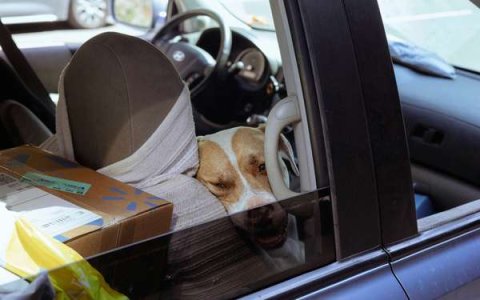The simple act that could cost you $2,000 this summer—are you making this risky mistake to help pets?
- Replies 0
Summer is here, and with it comes the irresistible urge to hit the open road—windows down, tunes up, and maybe your furry best friend riding shotgun.
But before you swing by the store or grab a quick bite, there’s a hidden danger lurking in the parking lot that could cost you more than just a guilty conscience.
In Delaware and many other states, a well-meaning attempt to rescue a pet from a hot car could land you with a whopping $2,000 fine—or even a lawsuit. Let’s unpack the rules, the risks, and what you should do if you spot a pet in peril.
Hot Cars: A Deadly Summer Trap for Pets
We all know the feeling: you spot a panting dog in a parked car on a sweltering day, and your heart sinks. It’s a scenario that plays out far too often.
Even with the windows cracked, the temperature inside a car can skyrocket in minutes—reaching deadly levels for pets.
According to the American Veterinary Medical Association, on a 85°F day, the temperature inside a car can hit 120°F in just 30 minutes. For our four-legged friends, that can mean heatstroke, brain damage, or worse.

The Law: Who Can Rescue, and Who Can’t?
Here’s where things get tricky. While your instincts might scream “smash the window and save the pup!”—Delaware law (and the law in 20 other states) says: not so fast.
In Delaware, only certain public officials—think police officers, animal control, firefighters, and animal cruelty investigators—are legally allowed to break into a car to rescue an animal in distress. These officials are protected from lawsuits or damages to the vehicle, so they can act quickly without fear of legal blowback.
But for the rest of us? The law is clear: if you take matters into your own hands, you could be slapped with a fine of up to $2,000.
And that’s not all—you might also be sued by the car or pet owner for damages. That’s a steep price for a good deed gone wrong.
Also read: Many chicks have been left without care—how you can offer support if you’re able
Why So Strict?
You might be wondering, “Why would the law punish someone for trying to help?”
The answer is complicated. Lawmakers want to protect animals, but they also want to prevent unnecessary property damage, mistaken assumptions, or even theft.
There have been cases where well-meaning citizens broke into cars only to find the pet was not in distress, or the car was running with the air conditioning on. The law aims to balance animal welfare with property rights and public safety.
What About Other States?
Not all states are as strict as Delaware. About a dozen states—including California, Florida, and Ohio—have “Good Samaritan” laws that allow anyone to break into a car to save an animal in immediate danger, as long as certain steps are followed (like calling 911 first and staying with the animal until help arrives).
But in Delaware and 20 other states, only designated officials have that authority.

What Should You Do If You See a Pet in a Hot Car?
If you spot an animal in distress inside a vehicle, here’s the safest—and legal—course of action:
1. Assess the Situation: Is the animal showing signs of heatstroke (excessive panting, drooling, lethargy, unresponsiveness)? Is the car running with the AC on?
2. Call for Help: Dial 911 or your local animal control immediately. Give them the car’s make, model, color, and license plate, and describe the animal’s condition.
3. Stay on the Scene: Wait for authorities to arrive. Your presence can help ensure the animal gets help as quickly as possible.
4. Alert Nearby Businesses: If you’re in a shopping center, ask staff to make an announcement to find the car’s owner.
Also read: This bizarre tiger case has a twist straight out of the Joe Exotic playbook
What NOT to Do:
- Don’t break the window yourself unless you’re in a state with a Good Samaritan law that protects you—and you’ve followed all required steps.
- Don’t leave the scene before help arrives.
- Don’t confront the car owner aggressively; let authorities handle the situation.
What Happens After a Rescue?
If an official rescues the animal, they’ll try to contact the owner. If that’s not possible, the pet may be taken to a local shelter, and the owner will be notified where to find their pet. The law also protects the owner from being sued by the rescuer for any injuries sustained during the rescue.
A Note on Prevention: Don’t Leave Pets in Cars—Ever
The best way to avoid tragedy (and legal headaches) is simple: never leave your pet unattended in a vehicle, even for a few minutes. Not only is it dangerous, but in many states, it’s also illegal. If you’re running errands, leave your pet at home where it’s cool and safe.
Read next: Are you unknowingly breaking this law at red lights? 31 states say you might be

Have you ever encountered a pet left in a hot car? Did you know about these strict rescue laws? Do you think Delaware should adopt a Good Samaritan law, or do you agree with the current approach? Share your stories, opinions, and questions in the comments below!
But before you swing by the store or grab a quick bite, there’s a hidden danger lurking in the parking lot that could cost you more than just a guilty conscience.
In Delaware and many other states, a well-meaning attempt to rescue a pet from a hot car could land you with a whopping $2,000 fine—or even a lawsuit. Let’s unpack the rules, the risks, and what you should do if you spot a pet in peril.
Hot Cars: A Deadly Summer Trap for Pets
We all know the feeling: you spot a panting dog in a parked car on a sweltering day, and your heart sinks. It’s a scenario that plays out far too often.
Even with the windows cracked, the temperature inside a car can skyrocket in minutes—reaching deadly levels for pets.
According to the American Veterinary Medical Association, on a 85°F day, the temperature inside a car can hit 120°F in just 30 minutes. For our four-legged friends, that can mean heatstroke, brain damage, or worse.

In Delaware and 20 other US states, only designated public officers—such as police, animal cruelty investigators, animal control officers, and firefighters—are legally permitted to rescue pets left unattended in hot cars. Image source: Connor Gan / Unsplash.
The Law: Who Can Rescue, and Who Can’t?
Here’s where things get tricky. While your instincts might scream “smash the window and save the pup!”—Delaware law (and the law in 20 other states) says: not so fast.
In Delaware, only certain public officials—think police officers, animal control, firefighters, and animal cruelty investigators—are legally allowed to break into a car to rescue an animal in distress. These officials are protected from lawsuits or damages to the vehicle, so they can act quickly without fear of legal blowback.
But for the rest of us? The law is clear: if you take matters into your own hands, you could be slapped with a fine of up to $2,000.
And that’s not all—you might also be sued by the car or pet owner for damages. That’s a steep price for a good deed gone wrong.
Also read: Many chicks have been left without care—how you can offer support if you’re able
Why So Strict?
You might be wondering, “Why would the law punish someone for trying to help?”
The answer is complicated. Lawmakers want to protect animals, but they also want to prevent unnecessary property damage, mistaken assumptions, or even theft.
There have been cases where well-meaning citizens broke into cars only to find the pet was not in distress, or the car was running with the air conditioning on. The law aims to balance animal welfare with property rights and public safety.
What About Other States?
Not all states are as strict as Delaware. About a dozen states—including California, Florida, and Ohio—have “Good Samaritan” laws that allow anyone to break into a car to save an animal in immediate danger, as long as certain steps are followed (like calling 911 first and staying with the animal until help arrives).
But in Delaware and 20 other states, only designated officials have that authority.

Members of the public who attempt to rescue an animal from a car in Delaware can face hefty penalties, including fines up to $2,000 and the risk of being sued by the vehicle owner. Image source: Jay Wennington / Unsplash.
What Should You Do If You See a Pet in a Hot Car?
If you spot an animal in distress inside a vehicle, here’s the safest—and legal—course of action:
1. Assess the Situation: Is the animal showing signs of heatstroke (excessive panting, drooling, lethargy, unresponsiveness)? Is the car running with the AC on?
2. Call for Help: Dial 911 or your local animal control immediately. Give them the car’s make, model, color, and license plate, and describe the animal’s condition.
3. Stay on the Scene: Wait for authorities to arrive. Your presence can help ensure the animal gets help as quickly as possible.
4. Alert Nearby Businesses: If you’re in a shopping center, ask staff to make an announcement to find the car’s owner.
Also read: This bizarre tiger case has a twist straight out of the Joe Exotic playbook
What NOT to Do:
- Don’t break the window yourself unless you’re in a state with a Good Samaritan law that protects you—and you’ve followed all required steps.
- Don’t leave the scene before help arrives.
- Don’t confront the car owner aggressively; let authorities handle the situation.
What Happens After a Rescue?
If an official rescues the animal, they’ll try to contact the owner. If that’s not possible, the pet may be taken to a local shelter, and the owner will be notified where to find their pet. The law also protects the owner from being sued by the rescuer for any injuries sustained during the rescue.
A Note on Prevention: Don’t Leave Pets in Cars—Ever
The best way to avoid tragedy (and legal headaches) is simple: never leave your pet unattended in a vehicle, even for a few minutes. Not only is it dangerous, but in many states, it’s also illegal. If you’re running errands, leave your pet at home where it’s cool and safe.
Read next: Are you unknowingly breaking this law at red lights? 31 states say you might be
Key Takeaways
- In Delaware and 20 other US states, only designated public officers—such as police, animal cruelty investigators, animal control officers, and firefighters—are legally permitted to rescue pets left unattended in hot cars.
- Members of the public who attempt to rescue an animal from a car in Delaware can face hefty penalties, including fines up to $2,000 and the risk of being sued by the vehicle owner.
- While protected officers receive civil immunity for vehicle damage during a rescue, Delaware law does not extend “Good Samaritan” protections to everyday citizens unlike some other American states.
- The law requires officers to contact the pet’s owner if possible or to leave their details and take the animal to a shelter if the owner cannot be found, ensuring the animal’s welfare after rescue.
Have you ever encountered a pet left in a hot car? Did you know about these strict rescue laws? Do you think Delaware should adopt a Good Samaritan law, or do you agree with the current approach? Share your stories, opinions, and questions in the comments below!






